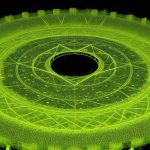Photo Credit: Ben Sasson
The Crop Circle Origin Debate: A Comprehensive Examination
The phenomenon of crop circles, intricate patterns formed in fields of crops, has captivated the public imagination for decades. These formations, which vary from simple circles to elaborate geometric designs, have spurred a variety of theories regarding their origins. Two prominent hypotheses dominate the debate: the extraterrestrial hypothesis, which suggests that these formations are messages from a higher intelligence, and the man-made theory, which posits that they are the result of human creativity or mischief. This essay aims to provide a balanced examination of both perspectives, exploring the evidence supporting each theory while acknowledging the limitations and uncertainties that accompany this mysterious phenomenon.
The Extraterrestrial Hypothesis
Proponents of the extraterrestrial hypothesis argue that crop circles are not merely artistic expressions or pranks, but rather sophisticated messages from higher intelligence or extraterrestrial beings. Supporters of this theory often point to several compelling factors:
- Strange Phenomena: Many reports associated with crop circles describe unusual occurrences such as light orbs, strange fogs, and residual patterns appearing in subsequent years. These phenomena are sometimes interpreted as signs of an otherworldly presence or advanced technology that creates the formations.
- Complexity and Design: The intricate patterns found in crop circles often exhibit complex geometric and fractal designs that some argue are beyond the capabilities of most humans. The precision and apparent divine nature of certain patterns, such as the intricate weaves and expanded nodes, are cited as evidence of a higher intelligence at work.
- Historical Context: The phenomenon of crop circles dates back to historical records from as early as the 1600s. The persistence and evolution of these formations over centuries contribute to the belief that they may be part of a long-term, sophisticated communication strategy.
Despite these points, the extraterrestrial hypothesis faces several challenges. The lack of concrete evidence connecting these phenomena to extraterrestrial life or advanced technology leaves room for skepticism. Additionally, the subjective nature of interpreting these patterns as messages from a higher intelligence complicates the validation of this theory.
The Man-Made Theory
The man-made theory suggests that crop circles are the result of human activity, either as elaborate hoaxes or artistic projects. This perspective is supported by several key arguments:
- Practicality and Effort: Creating crop circles requires considerable time and effort. Critics argue that the logistical challenges involved in planning and executing these designs—often perfectly formed on the first attempt—are significant. Despite this, many consider it improbable that such elaborate designs could be sustained over a 45-year period as a prank.
- Lack of Evidence: The absence of identifiable marks or proof of design is often cited as evidence that crop circles are man-made. If crop circles were indeed created by humans, one would expect to find practice circles or signatures left by the creators. The rarity of such evidence raises questions about the feasibility of the man-made theory.
- Legal and Ethical Issues: Crop circles frequently appear on restricted or private land without permission from the landowners. The choice of such locations, where the risk of detection and legal consequences is high, suggests that creating these formations could be driven by motives other than simple mischief.
- Economic and Social Factors: The idea that individuals would invest significant time and resources into creating crop circles, often at considerable personal risk, raises questions about their motivations. The lack of clear incentives or benefits for creating these patterns further complicates the man-made hypothesis.
The Limits of Knowledge and the Need for Cataloging
The debate over the origins of crop circles remains unresolved, largely due to the limitations of available evidence. While both theories have their merits, the absence of definitive proof for either hypothesis leaves the question open. It is crucial to acknowledge that there is likely a combination of phenomena at play—man-made hoaxes and genuine formations from unknown sources.
Given the complexity and ambiguity surrounding crop circles, the Crop Signals Project aims to provide a comprehensive database and analysis of these formations. By cataloging crop circles, including their locations, designs, and associated phenomena, the project seeks to uncover potential patterns and meanings. This effort contributes to the broader understanding of the phenomenon and may eventually shed light on its origins.
Conclusion
In conclusion, the origin of crop circles remains one of the great mysteries of contemporary times. While the extraterrestrial hypothesis offers a fascinating possibility, the man-made theory presents practical considerations that challenge its plausibility. As research continues, it is essential to approach the subject with an open mind and a commitment to unbiased investigation. The Crop Signals Project represents a significant step toward uncovering the truth, and continued exploration and analysis may eventually reveal the true nature of these enigmatic formations. Until then, the debate persists, highlighting the ongoing quest to understand one of the most intriguing phenomena of our time.








